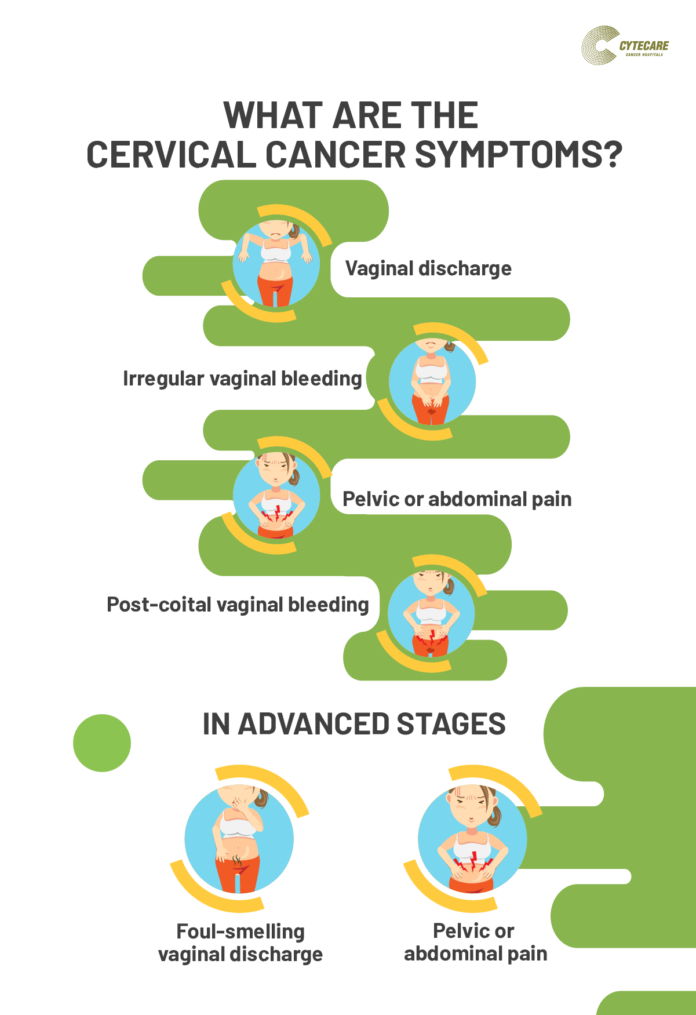Cervical cancer, the fourth most common cancer in women, affects the cervix, which is the narrow, cylindrical section of tissue that serves as the gateway between the vagina and the uterus. Glandular cells cover the endocervix, the area closest to the uterus, and squamous cells cover the exocervix, near the vagina. Most cervical cancers begin in the cells at the transformation zone, the point in the cervix where glandular and squamous cells meet.
According to the American Cancer Society, almost all cervical cancers are either squamous cell carcinoma or adenocarcinoma. On rare occasions, melanoma, sarcoma, and lymphoma may also be found in the cervix. (1)
Signs and Symptoms of Cervical Cancer
Typically, there are no symptoms for early stage cervical cancer. Most women experience symptoms only after the cancer invades nearby tissue. The most common symptoms are: (2)
- Longer or heavier than usual menstrual periods
- Bleeding after vaginal intercourse
- Post-menopausal bleeding
- Vaginal discharge that may contain blood between periods or after menopause.
- Pain during vaginal intercourse, even without bleeding or discharge.
How Is Cervical Cancer Diagnosed?
Cervical cancer is diagnosed using a Pap smear, which is a routine procedure performed during a gynecological exam, in which cells from the cervix are collected and screened in a lab for abnormalities.
If the Pap smear detects HPV, more testing, such as a colposcopy, may be performed to look for cells that might be cancerous. During a colposcopy, your doctor will use a magnification tool called a colposcope to closely examine the cervix, vagina, and vulva. A biopsy will likely be performed on tissue with any apparent abnormalities in order to screen for cancerous changes. There are several types of biopsies that your doctor may perform, depending on your case. The types include: (4)
- Punch biopsy During this procedure, your doctor uses a sharp tool to remove a core of tissue.
- Endocervical curettage Your doctor will use a small instrument to scrape tissue from the cervix.
- Electrical wire loop Your doctor will use a low-voltage electrified wire to remove a small sample from the cervix.
- Cone biopsy In this more extensive procedure, your doctor will remove a cone-shaped piece of tissue from the cervix
Prognosis of Cervical Cancer
When detected at an early stage, cervical cancer is typically curable. The five-year survival rate for stage 1 cervical cancer is above 90 percent. The development of screening methods, HPV vaccination, and improved access to screening has led to a steep decline in both the incidence of cervical cancer and deaths from the disease over the past half century. (5)
Complications of Cervical Cancer Treatment
The American Cancer Society lists several side effects of external beam radiation therapy for cervical cancer.
- Fatigue
- Upset stomach
- Diarrhea or loose stools (if radiation is given to the pelvis or abdomen)
- Nausea and vomiting
- Skin changes (from mild redness to peeling or flaking)
- Bladder irritation and dysfunction, blood in the urine
- Vaginal pain
- Menstrual changes
- Low blood counts
When chemotherapy is combined with radiation, blood counts may be lower and fatigue and nausea tend to be worse. These side effects typically improve in the weeks after treatment is stopped. Other, long-term side effects include vaginal scar tissue, dryness, rectal bleeding, urinary problems, and weakened bones. (8)
Black and Hispanic Americans and Cervical Cancer
More Black and Hispanic women get HPV-associated cervical cancer than women of other races or ethnicities, possibly because of decreased access to Pap testing or follow-up treatment. (10)
Resources We Love
Cervivor
This online community and advocacy organization helps patients and survivors connect and thrive through collective wisdom.
Foundation for Women’s Cancer
A 501(c)(3) nonprofit, this organization is dedicated to increasing public awareness of gynecological cancer risk, prevention, early detection, and optimal treatment.
Cervical Cancer-Free Coalition
CCF-America partners with community and government organizations as an advisory committee to provide information and support while carrying out community intervention projects.
National Cervical Cancer Coalition
A cervical cancer/HPV online support community of patients and caregivers who share personal experiences in a safe, secure environment.
Editorial Sources and Fact-Checking
- What Is Cervical Cancer? American Cancer Society. July 30, 2020.
- 6 Ways to Reduce Your Risk of Gynecologic Cancer. National Foundation for Cancer Research. September 28, 2017.
- Risk Factors for Cervical Cancer. American Cancer Society. January 3, 2020.
- Cervical Cancer: Diagnosis. Mayo Clinic. July 31, 2019.
- Survival Rates for Cervical Cancer. American Cancer Society. January 3, 2020.
- Cervical Cancer Treatment. Memorial Sloan Kettering Cancer Center.
- Human Papilloma Vaccines (HPV) Fact Sheet. National Institutes of Health. September 9, 2019.
- Managing Cancer-Related Side Effects. American Cancer Society.
- Cervical Cancer Statistics. Centers for Disease Control and Prevention (CDC). June 8, 2020.
- HPV-Associated Cervical Cancer Rates by Race and Ethnicity. CDC. September 3, 2020.













































